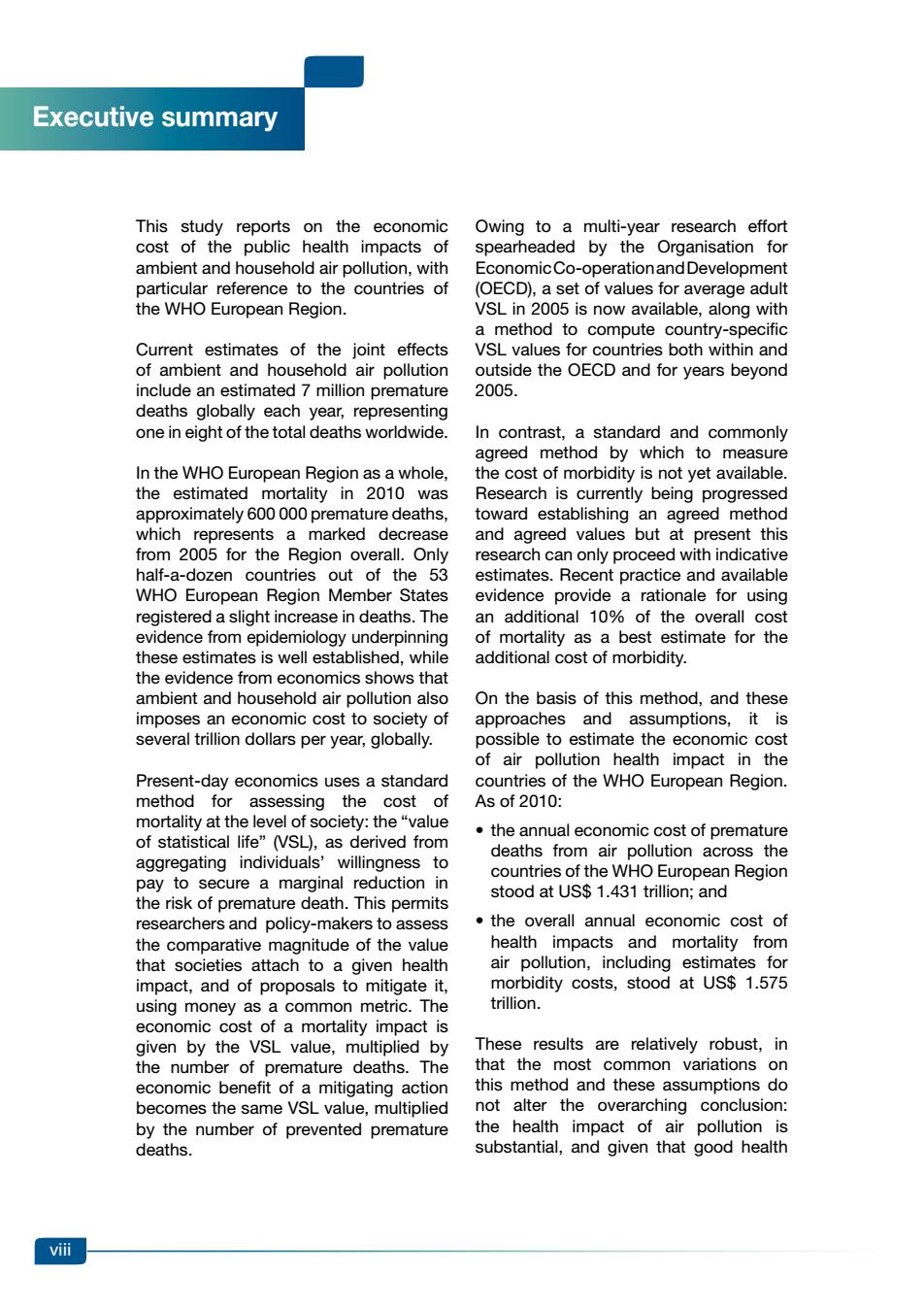正在加载图片...

Executive summary This study reports on the economic Owing to a multi-year research effort cost of the public health impacts of spearheaded by the Organisation for ambient and household air pollution,with Economic Co-operation and Development particular reference to the countries of (OECD),a set of values for average adult the WHO European Region. VSL in 2005 is now available,along with a method to compute country-specific Current estimates of the joint effects VSL values for countries both within and of ambient and household air pollution outside the OECD and for years beyond include an estimated 7 million premature 2005. deaths globally each year,representing one in eight of the total deaths worldwide. In contrast,a standard and commonly agreed method by which to measure In the WHO European Region as a whole, the cost of morbidity is not yet available. the estimated mortality in 2010 was Research is currently being progressed approximately 600 000 premature deaths, toward establishing an agreed method which represents a marked decrease and agreed values but at present this from 2005 for the Region overall.Only research can only proceed with indicative half-a-dozen countries out of the 53 estimates.Recent practice and available WHO European Region Member States evidence provide a rationale for using registered a slight increase in deaths.The an additional 10%of the overall cost evidence from epidemiology underpinning of mortality as a best estimate for the these estimates is well established,while additional cost of morbidity. the evidence from economics shows that ambient and household air pollution also On the basis of this method,and these imposes an economic cost to society of approaches and assumptions,it is several trillion dollars per year,globally. possible to estimate the economic cost of air pollution health impact in the Present-day economics uses a standard countries of the WHO European Region. method for assessing the cost of As of 2010: mortality at the level of society:the "value of statistical life"(VSL),as derived from the annual economic cost of premature deaths from air pollution across the aggregating individuals'willingness to pay to secure a marginal reduction in countries of the WHO European Region stood at US$1.431 trillion;and the risk of premature death.This permits researchers and policy-makers to assess the overall annual economic cost of the comparative magnitude of the value health impacts and mortality from that societies attach to a given health air pollution,including estimates for impact,and of proposals to mitigate it, morbidity costs,stood at US$1.575 using money as a common metric.The trillion. economic cost of a mortality impact is given by the VSL value,multiplied by These results are relatively robust,in the number of premature deaths.The that the most common variations on economic benefit of a mitigating action this method and these assumptions do becomes the same VSL value,multiplied not alter the overarching conclusion: by the number of prevented premature the health impact of air pollution is deaths. substantial,and given that good health viliviii Executive summary This study reports on the economic cost of the public health impacts of ambient and household air pollution, with particular reference to the countries of the WHO European Region. Current estimates of the joint effects of ambient and household air pollution include an estimated 7 million premature deaths globally each year, representing one in eight of the total deaths worldwide. In the WHO European Region as a whole, the estimated mortality in 2010 was approximately 600 000 premature deaths, which represents a marked decrease from 2005 for the Region overall. Only half-a-dozen countries out of the 53 WHO European Region Member States registered a slight increase in deaths. The evidence from epidemiology underpinning these estimates is well established, while the evidence from economics shows that ambient and household air pollution also imposes an economic cost to society of several trillion dollars per year, globally. Present-day economics uses a standard method for assessing the cost of mortality at the level of society: the “value of statistical life” (VSL), as derived from aggregating individuals’ willingness to pay to secure a marginal reduction in the risk of premature death. This permits researchers and policy-makers to assess the comparative magnitude of the value that societies attach to a given health impact, and of proposals to mitigate it, using money as a common metric. The economic cost of a mortality impact is given by the VSL value, multiplied by the number of premature deaths. The economic benefit of a mitigating action becomes the same VSL value, multiplied by the number of prevented premature deaths. Owing to a multi-year research effort spearheaded by the Organisation for Economic Co-operation and Development (OECD), a set of values for average adult VSL in 2005 is now available, along with a method to compute country-specific VSL values for countries both within and outside the OECD and for years beyond 2005. In contrast, a standard and commonly agreed method by which to measure the cost of morbidity is not yet available. Research is currently being progressed toward establishing an agreed method and agreed values but at present this research can only proceed with indicative estimates. Recent practice and available evidence provide a rationale for using an additional 10% of the overall cost of mortality as a best estimate for the additional cost of morbidity. On the basis of this method, and these approaches and assumptions, it is possible to estimate the economic cost of air pollution health impact in the countries of the WHO European Region. As of 2010: • the annual economic cost of premature deaths from air pollution across the countries of the WHO European Region stood at US$ 1.431 trillion; and • the overall annual economic cost of health impacts and mortality from air pollution, including estimates for morbidity costs, stood at US$ 1.575 trillion. These results are relatively robust, in that the most common variations on this method and these assumptions do not alter the overarching conclusion: the health impact of air pollution is substantial, and given that good health